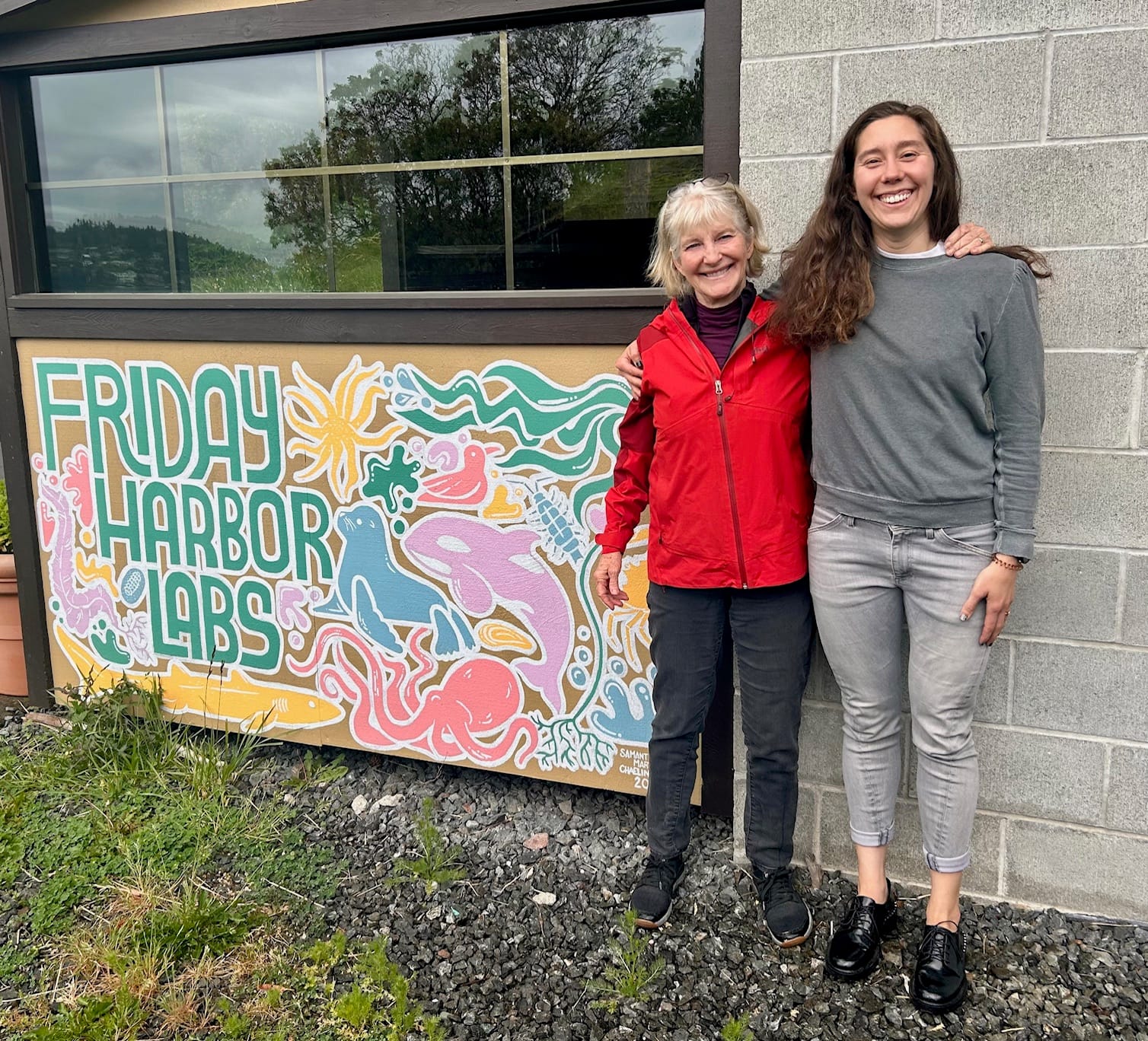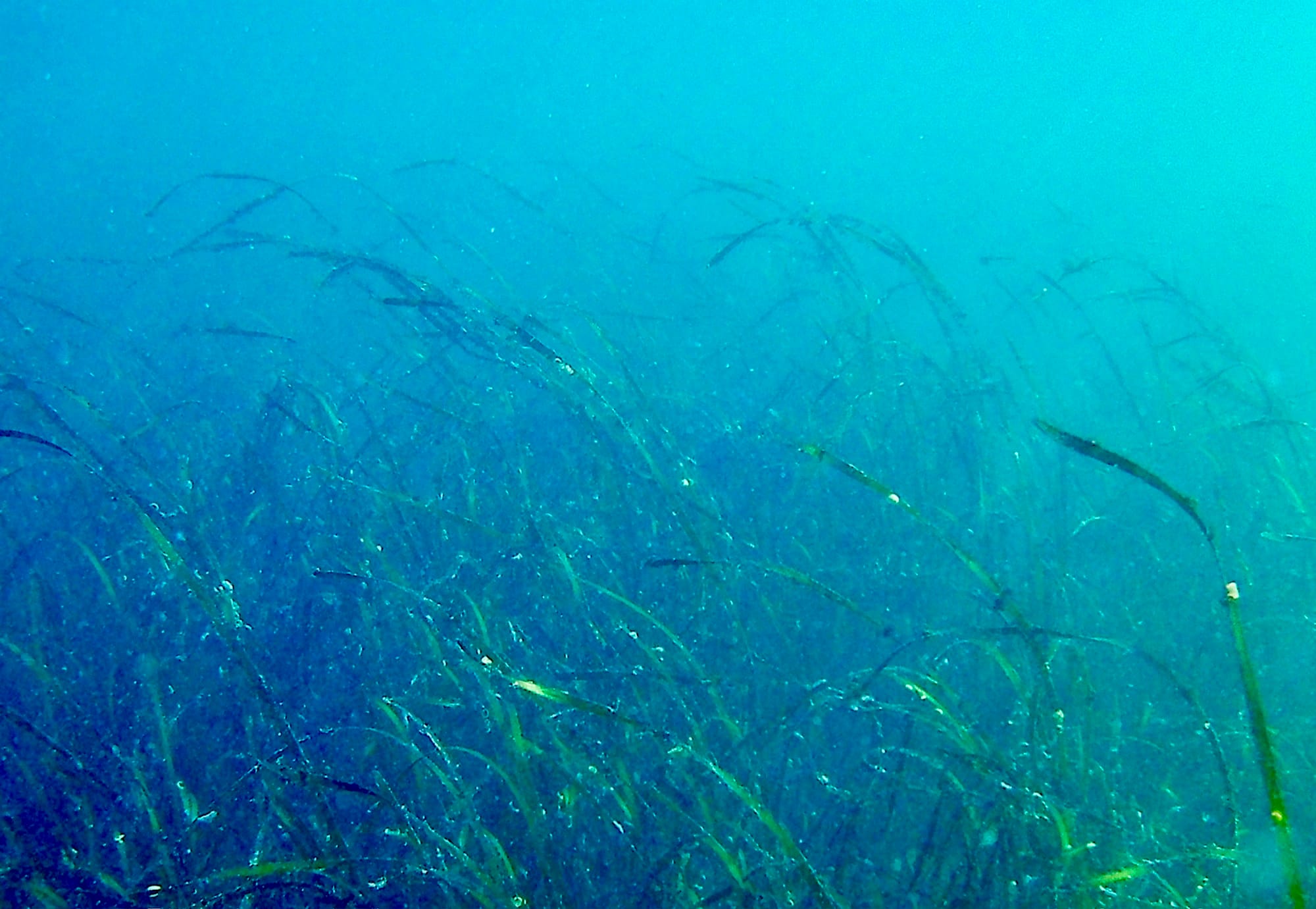This article originally appeared in the Salish Current.
Known for its importance as critical habitat for many species including juvenile salmon, eelgrass is the focus of a five-year study, now in its final year, in San Juan County. The project is a collaboration among the University of Washington Marine Labs in Friday Harbor, the State Department of Natural Resources (DNR) and Friends of the San Juans.
Using underwater video footage, snorkel surveys and drone footage, researchers are identifying precisely where eelgrass meadows are declining and where they are not. A detailed survey is mapping eelgrass in 21 bays and all marine shorelines in San Juan County.
Leading this research project is world-renowned scientist Drew Harvell, professor emerita of ecology and evolutionary biology at Cornell University. She teaches at the Friday Harbor Labs as an affiliate faculty in the School of Aquatic and Fishery Science, University of Washington.
Harvell’s research has focused on the health and sustainability of marine ecosystems around the globe, especially on the impact of disease and climate change. She has published three award-winning books and written over 190 scientific papers. She brings her global scientific perspective and research experience to the San Juan Islands, where she now lives.
Superpowers of eelgrass
Harvell uses the term “superpowers” to describe the functions of eelgrass in nature. It has three superpowers, she said. First, eelgrass meadows are “essential marine habitat” for many species of fish and invertebrates. Eelgrass is an important nursery and foraging area for multiple species. It provides habitat for key species impacting the entire food chain, including endangered ones such as the Southern resident killer whales.
Second, eelgrass mitigates the effects of climate change. “It absorbs carbon dioxide and locks it up in sediments, making it a valuable blue carbon offset.”
A third superpower is the ability of eelgrass to filter and remove human pathogens. A 2024 study Harvell participated in, published in Nature Sustainability, found that eelgrass reduced human pathogens in bivalves growing near eelgrass by as much as 65%.
Working alongside Harvell on this research in the San Juans is Olivia Graham, who has been studying eelgrass for 10 years. Graham is a marine disease ecologist and postdoctoral research associate with Cornell University, also living on San Juan Island and doing her work at Friday Harbor Labs.

Graham told Salish Current that eelgrass is important because, even more than rainforests, it’s the planet’s lungs: “You can see the oxygen bubbles streaming” from the blades of grass, she said. “They are powerhouses in fighting climate change.”
Not only do they produce oxygen, their roots store carbon, stabilize sediments and reduce the impact of wave action.
San Juan County: ‘An area of concerning losses’
The eelgrass predominant in the Salish Sea is Zostera marina, one of the world’s most widespread marine plant species. It grows along temperate and cold coastlines in the Northern Hemisphere from the high tide line to a depth of no more than 30 feet. The meadows exposed at low tide are in the intertidal area, while those submerged below the lowest tides are considered subtidal areas. This is important because while the intertidal meadows in San Juan County are declining, subtidal eelgrass areas are stable or growing.
Statewide, approximately 57,000 acres of eelgrass grow in inland marine waters. Much of it is concentrated in large bays such as Skagit County’s Padilla Bay. Most of the state’s eelgrass meadows have remained stable over the past decades, but eelgrass around the San Juan Islands exhibited four times as many sites with declines than with increases, according to a report done for the San Juan County Marine Resource Committee by the Pew Charitable Trust in 2022.
Over a third of San Juan County’s 408 miles of shoreline host eelgrass beds and meadows. DNR has identified the San Juan Islands as “an area of concerning losses” based on long-term and recent trends in the Puget Sound Eelgrass Vital Sign Indicator. Cynthia Catton, science advisor in DNR’s Aquatic Division, said the number of sites in the San Juans with declining eelgrass “significantly outnumbers those with increasing eelgrass.”
Study results to date show significant eelgrass declines in 12 of the 21 bays and increases at four sites, while five sites were identified as stable or having no clear trend.
Assessing the health of eelgrass is critical to understanding why the habitat is declining. The surveys show the San Juan Islands as a hotspot for both disease prevalence and severity, with both higher prevalence and severity found in the intertidal areas rather than subtidal ones, according to a paper published by Harvell, Graham and others in 2024, “Taking the Pulse of Resilience in Conserving Seagrass Meadows.”
They propose that the deeper eelgrass beds be recognized as refuge and protected.

The state legislature directed the DNR to identify at least 10,000 acres of priority kelp and eelgrass habitat for conservation and recovery in 2022, according to Catton. In some instances, restoring eelgrass beds by replanting has been attempted, but Harvell said this is risky and takes a long time. “It’s much more efficient to protect what we have,” she said.
One factor in the decline is wasting disease. Following her research on the loss of coral reefs caused by disease and warming temperatures, Harvell saw brown lesions growing on the green eelgrass blades and feared that wasting disease could impact eelgrass as it has sea stars, which suffered a massive die-off in 2013 but are slowly recovering.
Some of the largest eelgrass losses in the San Juan Islands have occurred in broad inlets, including Westcott Bay, Reef Net Bay, Shallow Bay and Swifts Bay, according to Catton. She said that DNR is working collaboratively with local partners to identify factors driving the loss and opportunities for improving resilience.
“A big stressor here,” Graham said, “is boat anchoring. It can scour the sea floor of eelgrass.” She said that Friends of the San Juans has developed a Green Boating program, providing maps to boaters showing where eelgrass is growing and urging them to anchor farther out. The organization is working on developing computerized mapping of eelgrass beds that will show up on boats’ navigation systems to help locate safe anchorages. “In the San Juans, this is really important,” Graham said, adding that new mooring buoys are not being permitted and the vast majority of them are unregulated.
Science based in the San Juans
It’s no coincidence that eelgrass research is centered in the San Juan Islands. It is recognized as an exceptionally rich area for marine organisms; and with a tidal range of about 14 feet, nearly all major groups of marine algae and invertebrates are represented here.
The University of Washington Marine Labs has quietly existed on San Juan Island for over 100 years. Harvell describes it as “one of the world’s notable marine biology field stations.”
Harvell’s connection there began with undergraduate study at the UW Friday Harbor Laboratory. She received her Ph.D. from the University of Washington in 1985, and, like Graham, went to work for Cornell University.
Both scientists contribute their expertise to the local community as volunteers: Harvell is a science advisor for Friends of the San Juans, and Graham was appointed by the County Council as a member of the County’s Marine Resource Committee.
Friday Harbor Labs director Megan Dethier said, “Our region and the Salish Sea in general is very fortunate to have diverse teams of highly qualified researchers seeking to understand eelgrass — its abundance and trends, its local importance as an essential habitat for other organisms, its susceptibility to disease and methods to restore it.”
Dethier said that teams of scientists from the conservation district and the labs, including a class of students this spring, are investigating optimal restoration methods. Pointing out all the collaboration among state agencies, nonprofits and scientists, she said, “Best of all, there is a strong spirit of cooperation among all these efforts and teams, with lots of data sharing and positive interactions.”
Graham described working at Friday Harbor Labs this way: “FHL is a petri dish: It brings together scientists from all walks of life and career stages, and after some incubation period, there is suddenly a robust, diverse community with all sorts of exciting interactions.”
The Salish Current originally published this article on Aug. 5, 2025.

